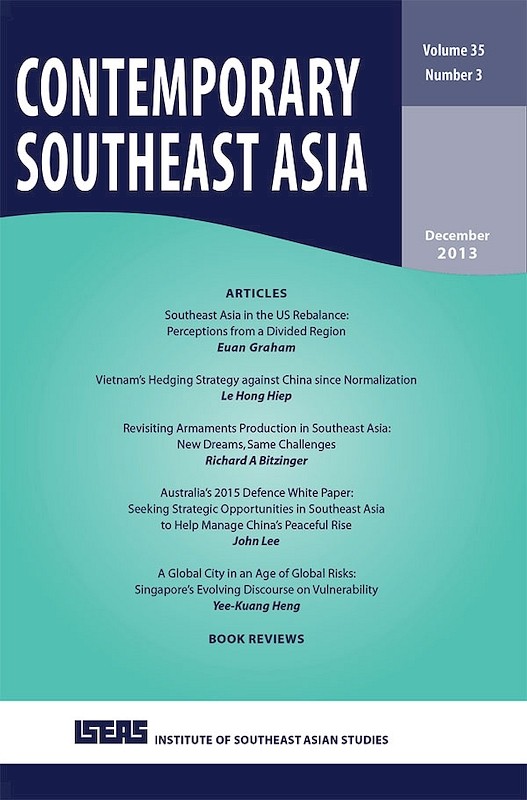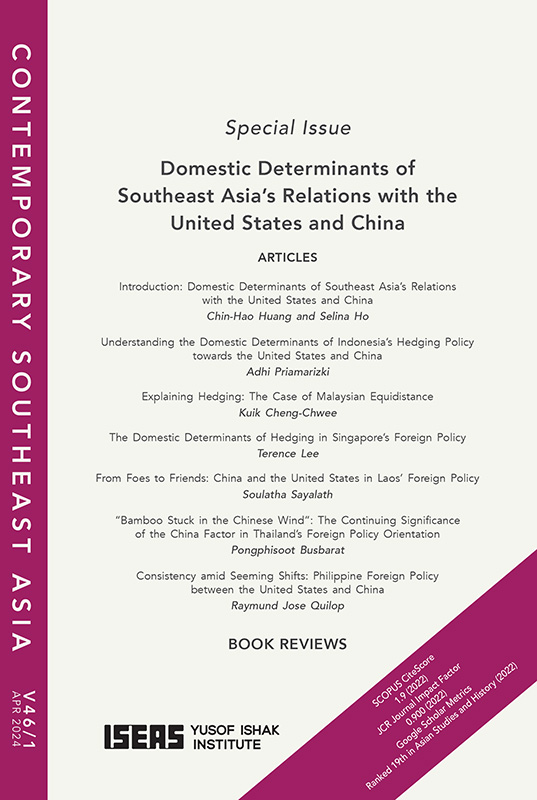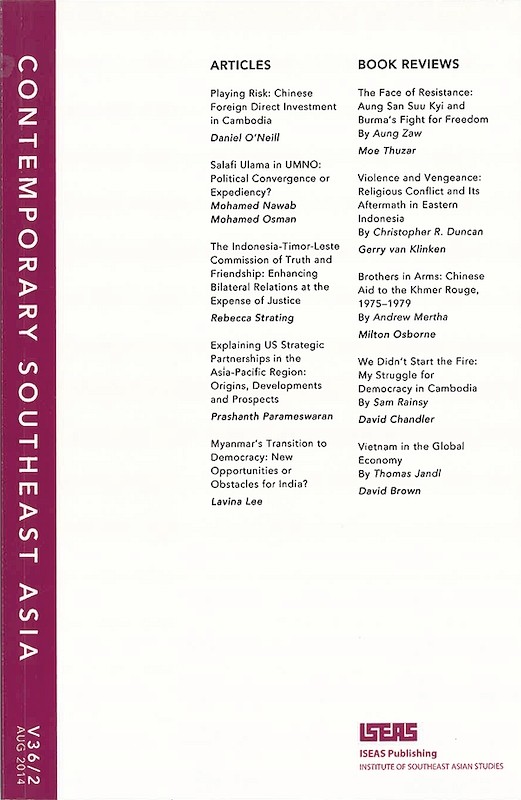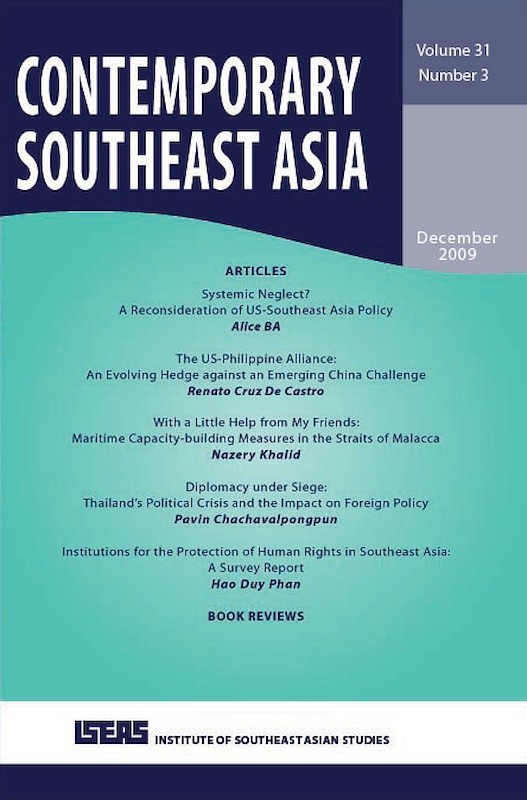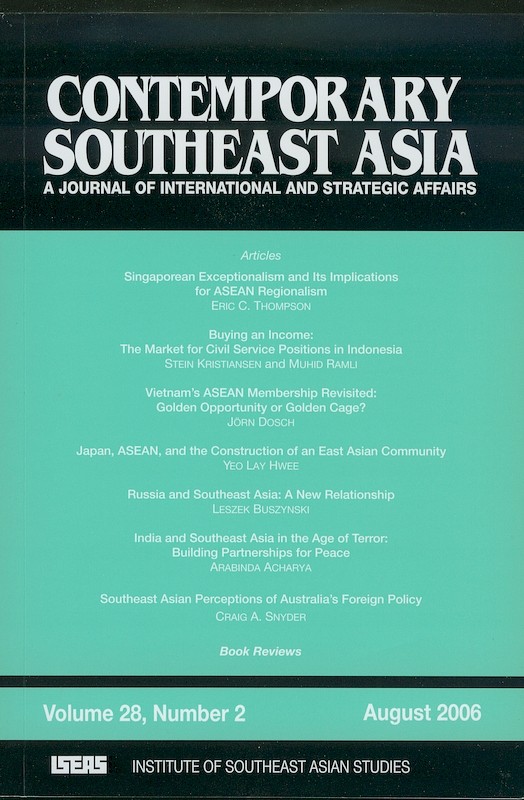Contemporary Southeast Asia Vol. 32/3 (Dec 2010). Special Focus on "America Re-engages Southeast Asia"
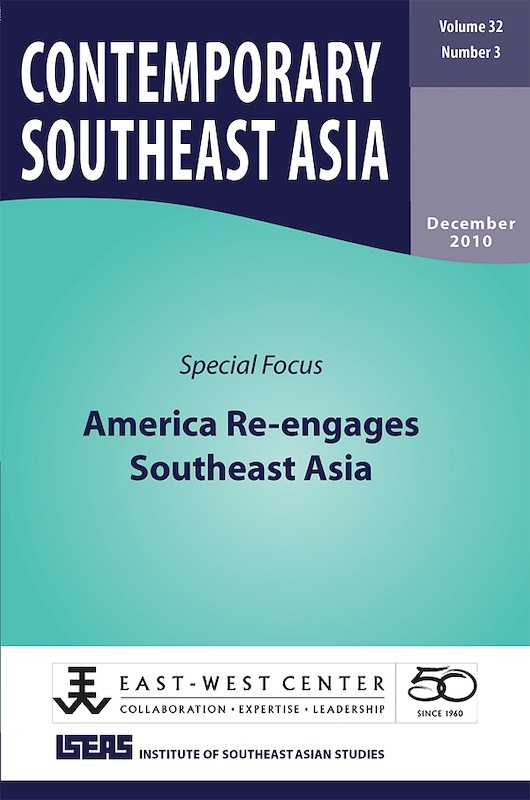
Date of publication:
December 2010
Publisher:
Institute of Southeast Asian Studies
Number of pages:
188
Code:
CS32/3
Contents
-
Contemporary Southeast Asia Vol. 32/3 (Dec 2010). Special Focus on "America Re-engages Southeast Asia"
[Whole Publication] -
Preliminary pages
- ARTICLES
-
Introduction: America's Bilateral Relations with Southeast Asia - Constraints and Promise, by Satu P Limaye, author
-
Rapprochement Between Vietnam and the United States, by Frederick Brown, Hoang Anh Tuan, authors see abstractThe improvement of bilateral relations between Vietnam and the United States has added a fresh dynamic to the geopolitics of Southeast Asia. This article discusses the laborious process of normalization of political relations between 1976 and 1995. It describes the course of economic normalization from the signing of the Bilateral Trade Agreement in 2001 and granting of Permanent Normal Trading Relations in 2006 to Vietnam's accession to the World Trade Trade Organization in 2007. It reviews current bilateral economic and trade issues and analyses domestic political norms and historical experiences which have acted as powerful forces shaping the foreign policies of both countries. The United States criticizes Vietnam's human rights record, and Vietnam has lingering qualms about alleged US designs for "regime change. The Vietnamese-American community, now 1.8 million strong, and the US Congress are major players in the expansion of bilateral relations. The article discusses the heightened visibility of ASEAN in US policy and implications for regional security. The article notes other positive factors at work in US-Vietnam relations: 13,000 Vietnamese now study in the United States; the sensitive Agent Orange issue is being addressed seriously; and there is bilateral cooperation on global warming, the environment, human trafficking and the Mekong River basin. The article concludes that US-Vietnam rapprochement is on a positive, mutually beneficial track but that its dimensions and durability have yet to be established.
-
US Rapprochement with Indonesia: From Problem State to Partner, by Ann Marie Murphy, Meidyatama Suryodiningrat, authors see abstractOver the past decade US relations with Indonesia have undergone a dramatic rapprochement such that today officials in both countries claim relations are at an all time high. Indonesia's transition to democracy and its adoption of effective counter-terrorism strategies laid the basis for the rapprochement. At a time when the Bush Doctrine advocated democracy as an antidote to terrorism, the Indonesian experience appeared to vindicate the logic of US policy. Under the Obama administration, policy towards Indonesia has been driven not only by shared democratic values and interests, but also by recognition that Indonesia is an emerging power that will play an increasingly influential role in global governance. The US and Indonesia are building a Comprehensive Partnership that creates a framework for enhanced security, economic and educational engagement, as well as cooperation on transnational issues such as climate change. For the relationship to reach its full potential, however, a series of obstacles must be overcome.
-
Prospects for Rapprochement Between the United States and Myanmar, by Priscilla Clapp, Harn Yawnghwe, authors see abstractHeld in a virtual state of suspended animation for the past twenty years, US relations with Myanmar have received fresh scrutiny as the country undergoes a political transition from martial law to quasi-parliamentary governance. As a result, the Obama administration has fashioned a new policy of pragmatic engagement to balance US sanctions against Myanmar's military regime, to reinvigorate Americas relations with ASEAN and to create a more flexible policy structure for fashioning US responses to a variety of possible outcomes in Myanmar's transition process. Whether this will lead to rapprochement between the two governments is uncertain, because the barriers to better understanding remain formidable on both sides. Furthermore, the shift in US policy over the past year has failed to produce a positive response from Naypyidaw. On the contrary, the Myanmar governments determination to manipulate the 2010 elections to disadvantage non-government parties, particularly the National League for Democracy (NLD), to pursue closer relations with North Korea and to allow rumours of a nascent nuclear weapons programme to persist have been interpreted in Washington as signs that Naypyidaw has no interest in engagement with the United States at this stage. Because US policy is influenced by a variety of constituencies both inside and outside government, the future direction of the new engagement policy will crucially depend on whether Myanmars elections result in genuine political and economic reform. In the absence of near-term progress, those promoting further sanctions are likely to exert pressure on the US government to take new measures, such as championing an international commission of inquiry into crimes against humanity by Myanmar's current top military leaders.
-
US Rapprochement with Laos and Cambodia, by Carlyle A. Thayer, Vatthana Pholsena , authors see abstractThis study analyses the process of rapprochement in United States relations with Laos and Cambodia. It discusses the key domestic and international factors that influenced decision-making in Washington, Vientiane and Phnom Penh to initiate this process. US-Lao rapprochement has evolved gradually since the mid-1980s. Lao assistance in accounting for US servicemen missing-in-action during the Vietnam War was a key driver. After ambassadorial relations were restored in 1992 both sides sought to address the concerns of the other and this led to an expansion of political, economic and military relations. US relations with Cambodia, experienced ups and downs due to the repressive policies of the Hun Sen government. Domestic upheaval in 1997 led the US to suspend economic assistance for a decade. Nevertheless, trade relations followed an upward trajectory as the US became Cambodia's most important market. In contrast to Laos, military-to-military relations developed considerably with a high point in 2009 with the visit of the Cambodian Defence Minister to Washington. This study highlights the importance of domestic factors driving rapprochement, with the role of the US Congress and Lao diaspora playing important roles. But external factors have also influenced this process, particularly after Laos and Cambodia became members of ASEAN and the Obama administration began to stress multilateral engagement. The upward trajectory of bilateral relations will continue to be constrained by the authoritarian nature of the Lao and Cambodian political systems and human rights abuses. But this factor will be mitigated somewhat by US geostrategic rivalry with China.
- BOOK REVIEWS
-
BOOK REVIEW: The Politics of Economic Regionalism: Explaining Economic Regional Integration in East Asia. By Kevin G. Cai, by Christopher M Dent, author
-
BOOK REVIEW: US-Chinese Relations: Perilous Past, Pragmatic Present. By Robert G. Sutter, by Denny C Roy, author
-
BOOK REVIEW: Malaysia at the United Nations: A Study of Foreign Policy Priorities, 1957-1987. Second Edition. By Rajmah Hussain, by Johan Saravanamuttu, author
-
BOOK REVIEW: Anomie and Violence: Non-truth and Reconciliation in Indonesian Peace Building. By John Braithwaite, Valeria Braithwaite, Michael Cookson and Leah Dunn, by David Jansen, author
-
BOOK REVIEW: Peace and Security in the Asia-Pacific: Theory and Practice. By Sorpong Peou, by Pavin Chachavalpongpun, author

